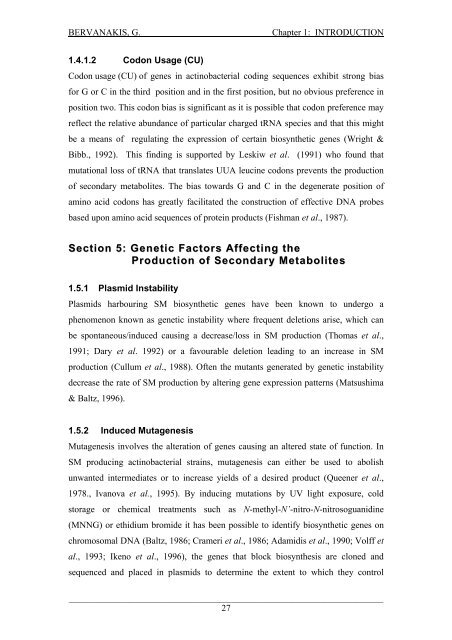Detection and Expression of Biosynthetic Genes in Actinobacteria ...
Detection and Expression of Biosynthetic Genes in Actinobacteria ...
Detection and Expression of Biosynthetic Genes in Actinobacteria ...
You also want an ePaper? Increase the reach of your titles
YUMPU automatically turns print PDFs into web optimized ePapers that Google loves.
BERVANAKIS, G.Chapter 1: INTRODUCTION1.4.1.2 Codon Usage (CU)Codon usage (CU) <strong>of</strong> genes <strong>in</strong> act<strong>in</strong>obacterial cod<strong>in</strong>g sequences exhibit strong biasfor G or C <strong>in</strong> the third position <strong>and</strong> <strong>in</strong> the first position, but no obvious preference <strong>in</strong>position two. This codon bias is significant as it is possible that codon preference mayreflect the relative abundance <strong>of</strong> particular charged tRNA species <strong>and</strong> that this mightbe a means <strong>of</strong> regulat<strong>in</strong>g the expression <strong>of</strong> certa<strong>in</strong> biosynthetic genes (Wright &Bibb., 1992). This f<strong>in</strong>d<strong>in</strong>g is supported by Leskiw et al. (1991) who found thatmutational loss <strong>of</strong> tRNA that translates UUA leuc<strong>in</strong>e codons prevents the production<strong>of</strong> secondary metabolites. The bias towards G <strong>and</strong> C <strong>in</strong> the degenerate position <strong>of</strong>am<strong>in</strong>o acid codons has greatly facilitated the construction <strong>of</strong> effective DNA probesbased upon am<strong>in</strong>o acid sequences <strong>of</strong> prote<strong>in</strong> products (Fishman et al., 1987).Section 5: Genetic Factors Affect<strong>in</strong>g theProduction <strong>of</strong> Secondary Metabolites1.5.1 Plasmid InstabilityPlasmids harbour<strong>in</strong>g SM biosynthetic genes have been known to undergo aphenomenon known as genetic <strong>in</strong>stability where frequent deletions arise, which canbe spontaneous/<strong>in</strong>duced caus<strong>in</strong>g a decrease/loss <strong>in</strong> SM production (Thomas et al.,1991; Dary et al. 1992) or a favourable deletion lead<strong>in</strong>g to an <strong>in</strong>crease <strong>in</strong> SMproduction (Cullum et al., 1988). Often the mutants generated by genetic <strong>in</strong>stabilitydecrease the rate <strong>of</strong> SM production by alter<strong>in</strong>g gene expression patterns (Matsushima& Baltz, 1996).1.5.2 Induced MutagenesisMutagenesis <strong>in</strong>volves the alteration <strong>of</strong> genes caus<strong>in</strong>g an altered state <strong>of</strong> function. InSM produc<strong>in</strong>g act<strong>in</strong>obacterial stra<strong>in</strong>s, mutagenesis can either be used to abolishunwanted <strong>in</strong>termediates or to <strong>in</strong>crease yields <strong>of</strong> a desired product (Queener et al.,1978., Ivanova et al., 1995). By <strong>in</strong>duc<strong>in</strong>g mutations by UV light exposure, coldstorage or chemical treatments such as N-methyl-N’-nitro-N-nitrosoguanid<strong>in</strong>e(MNNG) or ethidium bromide it has been possible to identify biosynthetic genes onchromosomal DNA (Baltz, 1986; Crameri et al., 1986; Adamidis et al., 1990; Volff etal., 1993; Ikeno et al., 1996), the genes that block biosynthesis are cloned <strong>and</strong>sequenced <strong>and</strong> placed <strong>in</strong> plasmids to determ<strong>in</strong>e the extent to which they control_____________________________________________________________________27















